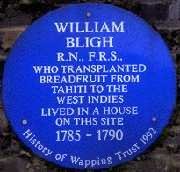
Capt. William Bligh.
Rearden Street on an old brick wall. The house is no longer standing. Walter Bligh commanded a ship on one of Captain Cook's voyages. He is best known as the commander of HMS Bounty when a mutiny took place in the Pacific Ocean. He was set adrift in a small open boat with 18 of his crew. With no maps to guide him, he successfully navigated nearly 3600 miles to land in Timor after an epic journey lasting 45 days. The mutineers settled in the Pitcairn Islands. By the time that he retired he had reached the rank of admiral. (See No. 1. on Map)
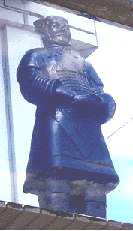
Mandarin.
Cinnabar Wharf, central block, Wapping High Street. This life-sized mandarin-like figure stands on a first floor balcony staring out over the river. (See No. 2. on Map)
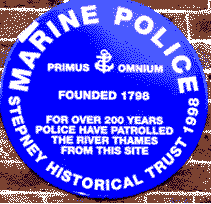
Marine Police.
Wapping High Street. See Thames Police Boat Station for the history. This building still has a jetty at the back, where you will usually see police launches tied up ready for duty. (See No. 3. on Map)
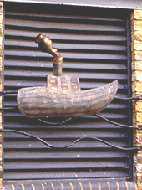
Marine Sculptures.
Overlooking the grass area by the Marine Police Station in Wapping High Street. This one of a series of metal sculptures guarding the ground floor windows, all of which have a maritime theme. (See No. 4. on Map)
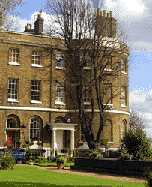
Wapping Pier Head.
Wapping Pier Head, Wapping High Street. The buildings date from c. 1800. Customs officers responsible for examining and taxing goods imported via Wapping had their headquarters here. The cobbled street adds to the feeling of antiquity of the group of old houses around the central garden. (See No. 5. on Map)
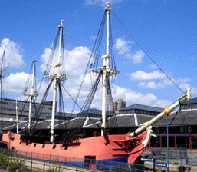
"Pirate Ships."
Tobacco Dock off Wapping Lane. The illustration shows the 'Three Sisters', one of two "pirate ships" permanently displayed here. They are reminders of some of the ships which used to unload cargo here. Here you can also see What Happened to Pirates who were caught. (See No. 6. on Map )

Thames Police Boat Station.
Wapping High Street. This modern building with strikingly designed walls does not look like a conventional police station. Only the blue colour of parts of the building give a hint that this is part of the Metropolitan Police Boat Yard. There has been a Marine Police Office in this area since 1798, and a building further down Wapping High Street has a plaque to commemorate the fact. This police was necessary to try to reduce the amount of pilfering when ships in mid stream were unloaded into barges and then a second time onto shore. A few years later, docks were opened which allowed cargoes to be offloaded to the shore direct. Near to this building there used to be an area known as Execution Dock. There was a gibbet permanently set up, and many pirates and other criminals met their end here. One of the most notorious of these was Captain William Kidd, who was found guilty of piracy in 1701. (There is a pub nearby named after him.) Long before this, the custom was to set up a gibbet near the low tide mark, hang the criminal and let his body remain there until three tides had washed over it. (See No. 7. on Map )
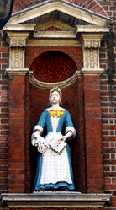
Raine's School.
Raine Street. This is the original building of the school and dates from 1719. The illustration shows one of a pair of statues of pupils which show a marked resemblance to those on St John's Old School. The inscribed stone over the main entrance states:
|
YOUR DUTY TO GOD & MAN 1719 |
Henry Raine (1679 - 1738), a Wapping brewer, financed this charitable school, which still continues in different premises today under the Raine Foundation. He is buried in St George's churchyard in an impressive tomb. The street is named after him. (See No. 8. on Map)
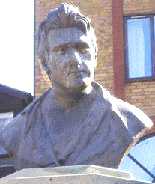
John Rennie.
Spirit Quay. John Rennie (1761-1821) was a Scottish engineer. Among many others, he built Southwark and Waterloo Bridges and planned the 1831 London Bridge. But he died before the latter was finished and it was completed by his son, Sir John Rennie. His bust is placed here because he designed both the London and the East India docks. (See No. 9. on Map)
Artist: John Revera.
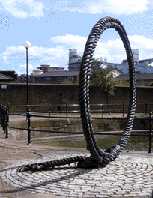
Rope Circle.
Hermitage Basin. This sculpture is made out of ships hawsers which have been shaped and stiffened to keep their form. The Sculptor's studio is in the old pump house at the other end of the Basin. (See No. 10. on Map)
Sculptor: Wendy Ann Taylor. Date: 1997. See also by the same artist: "Docklands Enterprise", "Knowledge", "Timepiece" and "Voyage 2001"
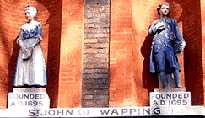
St John's School.
St John's Old School, Scandrett Street, Wapping. The school was founded in 1695, but the present building only dates back to 1756. On the front of the building are statues of two of the pupils in their traditional uniforms. Boys and girls were segregated in schools until the middle of the twentieth century, and used to enter the school buildings by separate entrances. (See No. 11. on Map)

St John's Tower.
Scandrett Street. This tower was all that remained of the mid 18th century church after the bombing of World War 2. Recently the site has been developed and it now has two modern wings attached. St John's had been the parish church, but now the tower and the new additions have bee used for apartments and the churchyard has become a small park. (See No. 12. on Map)
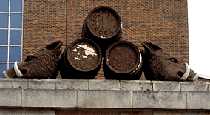
Tobacco Dock.
Over the entrance in Wapping Lane. The boar's heads and barrels are a reminder of some of the goods passing through this dock. Wines, spirits and animal furs were common commodities unloaded here. This dock was in use from 1812 to 1989. (See No. 13. on Map )
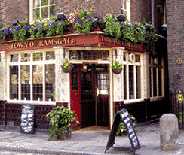
The Town of Ramsgate.
Wapping High Street by Wapping Old Steps. This old pub, which claims to be the oldest on the river, is now a grade II listed building. It dates from 1758 for its first few years it was known as the Prince of Denmark. About this time there were more than 140 ale-houses in Wapping High Street and all with a doubtful reputation. The bar is long and very narrow, because the pub was squeezed in between the path to Wapping Old Steps and the building on its other side. Ship's passengers arrive and departed via these steps. One of the most notorious was Judge Jeffreys, who was called "the hanging judge" because of his cruelty in sentencing the followers of the Duke of Monmouth in his attempted rebellion of 1685. He planned to escape retribution by fleeing the country. While waiting for his ship to depart from Wapping Old Steps, he went to drink in a nearby pub called the Red Cow. Although disguised as a sailor, he was recognised by a man who had once come up before him in court. The latter said that he would never forget a face as evil as that of Judge Jeffreys. The judge was arrested held in the Tower and later executed. (See No. 14. on Map)
Date: 1758.
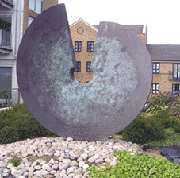
"Voyage 2001."
At the side of the Thames, off Wapping High Street, between the Central and East blocks of Cinnabar Wharf. Artist says that the shape of the design was inspired by ships propeller made by Ethan Baldwin in 1850. Her intention was to link the maritime history of the area with modern sculpture and architecture. (See No. 15. on Map)
Sculptor: Wendy Taylor. 2001. (See also "Docklands Enterprise", "Knowledge", "Rope Circle" and "Timepiece" by the same artist.)
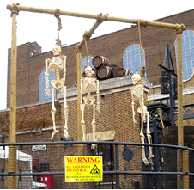
What Happened To Pirates.
Tobacco Dock. This gruesome display was set up in 2005, but had been taken down by January 2006. Presumably to attract summer visitors (except pirates). Pirates who were caught were usually hanged, but not here. The usual place for this was Execution Dock beside the Thames in Wapping near the Thames Police Boat Station. (For Tobacco Dock see No. 33. on Map)